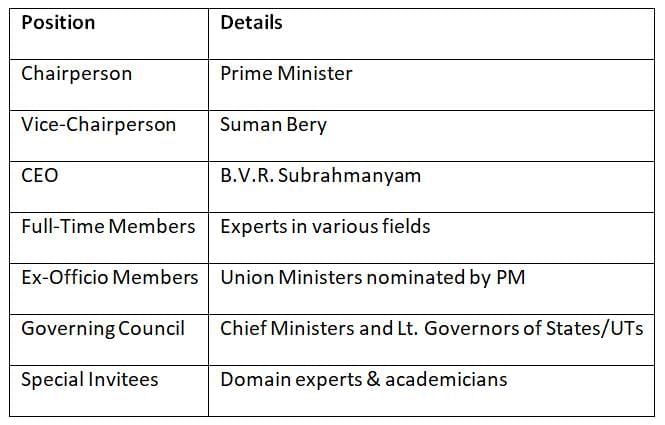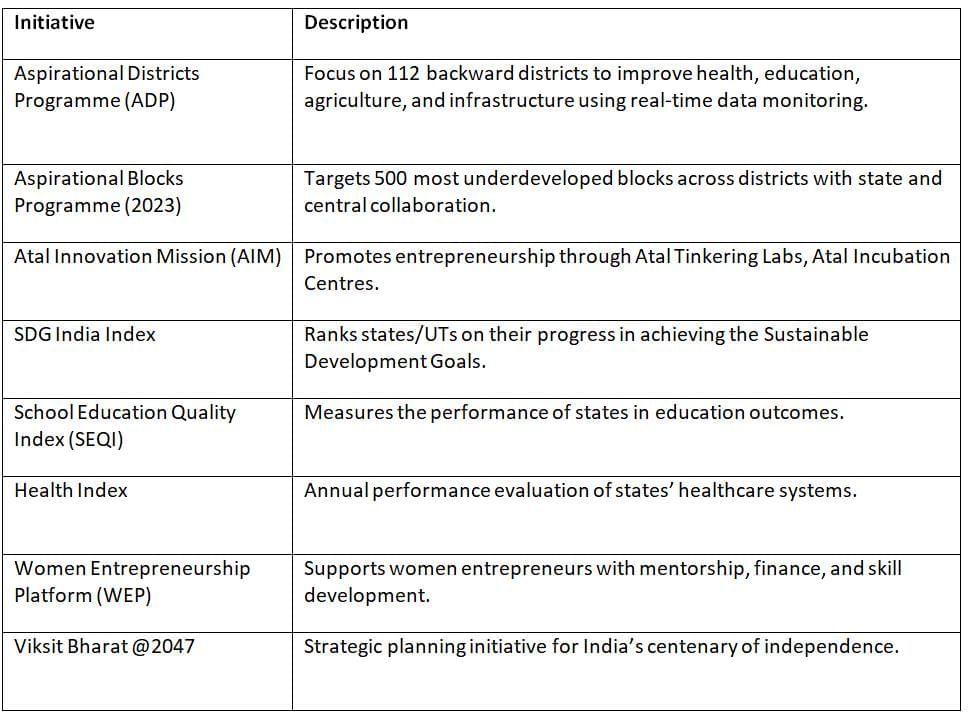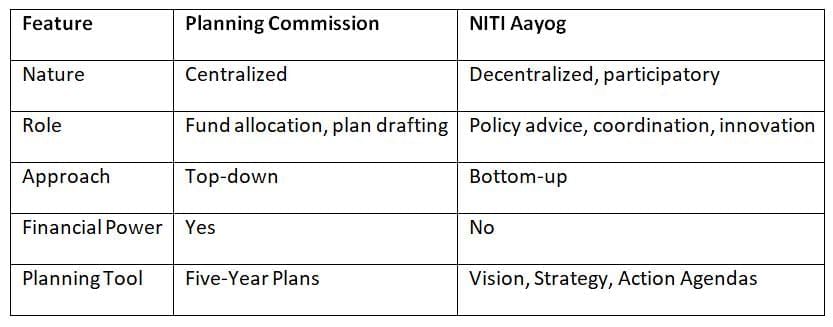UPSC Exam > UPSC Notes > Indian Economy for UPSC CSE > Cheat Sheet: NITI Aayog (National Institution for Transforming India)
Cheat Sheet: NITI Aayog (National Institution for Transforming India) | Indian Economy for UPSC CSE PDF Download
| Table of contents |

|
| Background |

|
| Composition |

|
| Major Functions |

|
| Key Initiatives |

|
| Comparison: NITI Aayog vs Planning Commission |

|
| Recent Developments |

|
| Criticism |

|
Background
- Established on 1 January 2015, replacing the Planning Commission (1950–2014).
- Aims to promote cooperative and competitive federalism.
- Designed as a policy think tank and not a funding body.
- Emphasizes bottom-up planning, aligning with the changing governance structure.
Composition

Key Objectives
- Develop strategies and long-term policies for India’s socio-economic transformation.
- Strengthen cooperative federalism by promoting active state involvement.
- Serve as a platform for knowledge sharing and policy convergence.
- Provide directional and policy inputs to the Centre and States.
Major Functions
- Policy Formulation: Develop vision, strategy, and action agenda (e.g., Strategy @75).
- Monitoring & Evaluation: Outcomes-based performance tracking of government schemes.
- Innovation Promotion: Through Atal Innovation Mission (AIM).
- Data-Driven Governance: Real-time dashboards, SDG tracking, sector indices.
- Capacity Building: Especially for aspirational and backward regions.
Key Initiatives

Comparison: NITI Aayog vs Planning Commission

Recent Developments
- Viksit Bharat @2047: Vision plan for a developed India by 2047; state-wise consultations underway.
- G20 Follow-up: Focus on digital public infrastructure, AI regulation, and climate financing.
- Green Growth Models: Partnerships with states on circular economy, renewable energy roadmaps.
- New Thematic Dashboards: On women-led development, climate action, and digital health.
- Greater Role in PLI Monitoring: Tracking the performance of Production Linked Incentive schemes.
Criticism
- Lacks statutory status, reducing its institutional authority.
- No financial devolution power, hence influence is limited to persuasion and advice.
- Some critics argue it reflects central priorities more than state-specific needs.
- Evaluation capacity of flagship schemes needs further institutional strengthening.
The document Cheat Sheet: NITI Aayog (National Institution for Transforming India) | Indian Economy for UPSC CSE is a part of the UPSC Course Indian Economy for UPSC CSE.
All you need of UPSC at this link: UPSC
|
108 videos|425 docs|128 tests
|
FAQs on Cheat Sheet: NITI Aayog (National Institution for Transforming India) - Indian Economy for UPSC CSE
| 1. What is the primary purpose of NITI Aayog and how does it differ from the Planning Commission? |  |
Ans. The primary purpose of NITI Aayog (National Institution for Transforming India) is to promote sustainable and inclusive development in India through cooperative federalism. It aims to involve states in the policymaking process and provide a platform for collaborative decision-making. In contrast, the Planning Commission focused on centralized planning and had a more top-down approach to economic development.
| 2. What are the major functions of NITI Aayog? |  |
Ans. NITI Aayog has several major functions, including formulating strategic and long-term policies, fostering cooperative federalism, monitoring and evaluating programs and initiatives, promoting research and innovation, and providing technical expertise to states and Union Territories. It also plays a crucial role in facilitating the implementation of sustainable development goals.
| 3. What key initiatives has NITI Aayog launched to support its objectives? |  |
Ans. NITI Aayog has launched various key initiatives, such as the Atal Innovation Mission, which promotes innovation and entrepreneurship, the Sustainable Development Goals (SDG) India Index to track progress on SDGs, and the Digital India initiative to enhance digital infrastructure and governance. These initiatives aim to drive economic growth and improve living standards across the country.
| 4. How does NITI Aayog's approach to planning differ from that of the Planning Commission? |  |
Ans. NITI Aayog adopts a more decentralized and collaborative approach compared to the Planning Commission. It emphasizes the importance of states' involvement in policy formulation, allowing for tailored strategies that address local needs. The Planning Commission was more focused on setting rigid targets and allocations centrally, while NITI Aayog encourages flexibility and adaptability in planning processes.
| 5. What criticisms has NITI Aayog faced since its establishment? |  |
Ans. NITI Aayog has faced several criticisms, including accusations of lacking adequate powers and resources to implement its initiatives effectively. Some critics argue that it has not fully replaced the Planning Commission's structure in terms of financial allocations and planning. Additionally, there are concerns about its limited role in addressing regional disparities and ensuring equitable development across states.
Related Searches















